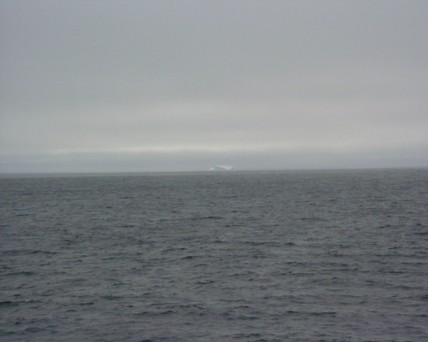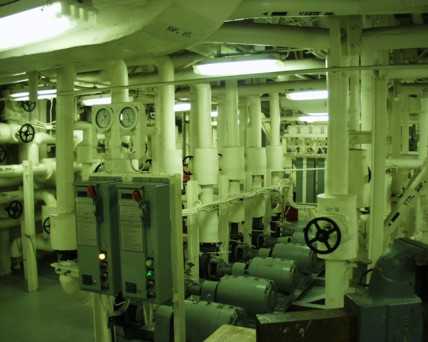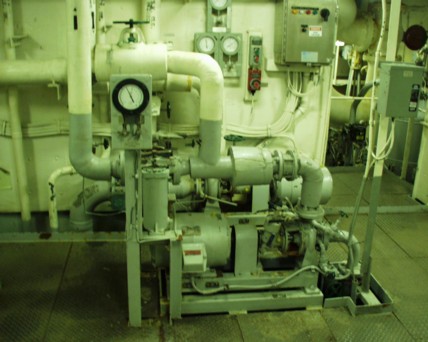|
|
Expedition
Expedition | People
|
Log - July-23-2003
by Gerhard Behrens and Robert McCarthy
Previous | Next
| Water, water everywhere |
| First the answers from yesterday's questions: The amount of seawater displaced when the fuel tanks are filled is 3,975,000 liters, which is about 4,066,500 kg (4500 tons).
|
 |
Last night I saw my first iceberg, and although we didnít get too close, it was impressive for a ďlittle-oneĒ. It was hard to judge the size of it, but letís say that it was 20 meters high, 100 meters long, and 100 meters wide. Letís calculate how many gallons of fresh water is contained in that iceberg. First we need the volume of the iceberg exposed, 200,000 meters cubed. Knowing the density of ice is 920 kg per meters cubed, and the density of seawater is 1023 kg per meter cubed, we can determine how much ice is below the water line. Archimedes Principle states that the weight force down is equal to the weight of the displaced fluid. So the ratio of the two densities will give the fraction of the volume of the total iceberg that is submerged (displacing the water). Here, it turns out that 90% of the iceberg is submerged, or 10% is visible. This means that the volume of the total iceberg is 2 million meters cubed, which is 2 billion liters of fresh water. This equates to 530 million gallons of water!!
|
Speaking of fresh water, the ship has to create its own fresh water while at sea. There are a few ways to do this, reverse osmosis and evaporators are the two most common. The USCG Healy uses evaporators, and can generate about 6600 gallons per day, (thatís about 55 gallons per person per day with a crew of 120 on board). They pump seawater into the ship, and decrease the pressure so it will boil at a lesser temperature. The steam then passes over some condensers, and fresh water drips into collection pans. This water then goes through a bromine filter, and is extremely pure. The Healy can hold about 28,000 gallons of water combined in two tanks, and conservation measures are taken if the level reaches half that amount.
On a side note, we've been heading about 346 degrees for the last day (slightly west), and we gained back the half hour time zone of Newfoundland. So now we are only 1 hour ahead of Eastern Standard Time. We are just now crossing over latitude 60 degrees north. Still a long way to go before our first station in the middle of Baffin Bay.
|
 |
We are still steaming north towards Baffin Bay and the Nares Straight, on our way to the places where we will do the science work. The ship had to slow down because we moved into some fog. The ship even stopped for a few hours, too, because of an engine problem. It made me realize that we never know what might happen, and that crew and scientists have to deal with any problems that come up. Flexibility, Patience, and Problem Solving are important personal skills to pack in your bag! |
 |
“Water, water everywhere, but not a drop to drink.” This is one of those places where that saying is really true, and another problem to be solved. All ships need fresh water, from the smallest sailboat to the biggest aircraft carrier. Many boats have tanks for storing fresh water, but this ship needs lots of fresh water. There is cooking, washing dishes, general cleaning up, doing laundry, taking showers, drinking, running science experiments, and keeping engines cool. The engineers figure each person needs about 50 gallons a day, so the ship goes through about 5,000 gallons every day. Where do we get it? |
|
The Healy makes its own fresh water from seawater. Think about the water cycle: evaporation—condensation—precipitation—transportation. Water is pumped in from the sea (transportation). It is piped into a place where they add pressure and heat so the water boils (evaporation). The water vapor turns into water drops as it hits a cooling tray (condensation). Those drops fall into a pan (precipitation). The salt and minerals of ocean water are left behind and fresh water flows through a bromine filter to make sure it is safe to drink. Finally, it is pumped all over this huge ship through a maze of pipes
(transportation). |
| An evaporator can make about 6,600 gallons a day. There are two of them, just in case one needs cleaning or it breaks. All the water is stored in two, huge, containers. Each one holds 14,000 gallons. Everyone on the ship takes “sea showers” to save water. In a sea shower, you get yourself wet and turn off the water. Then you soap up and scrub. Last, you turn on the shower once more to rinse. |
| For lots of reasons, the water level can get low. When that happens, the first step is to put a limit on showers. The next step is to stop doing laundry. After that, everyone has to eat with paper plates and plastic utensils. That doesn’t happen too often on the Healy, but when it does, everyone has to use Flexibility, Patience, and Problem Solving. |
|
